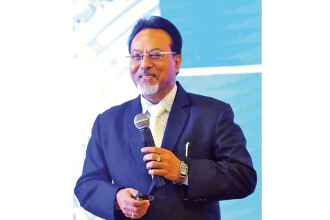
Rashik Adhikari is the Founder of Covered by Sage established in early 2019. It is a digital insurance platform which is Nepal-based and covers the insurance market in the US. Adikari dropped out of Harvard Business School two years into his college education to start Covered by Sage. “We started this product company to make brokerage fair by giving agents better economics and greater experience. That required building a brokerage from ground-up. We are doing just that,” he says. He also has a similar product company in Vishakapatnam, India. Currently, he is working on building the team in the capital.
In an interview with Business 360’s Ankita Jain, Rashik Adhikari talks about the need for digital insurance platform, the reason behind less insurance penetration in the country, risk management market and his views on the entrepreneurial landscape here. Excerpts:
Why is digital tech the way forward for insurance companies?
Technology is integrated in all industries and insurance is one of them. There are so many ways that technology impacts the industry especially in the US market. Tech in all the right places can do all the right things. The ground reality is people usually do not change their insurance agents until and unless something bad happens. And this gives the industry an excuse to not adapt with tech. On this note the customer suffers the most. As an agency we work with a lot of agents to enable them with smooth flow of their businesses.
On the other hand, it is said that technology will disseminate the role of traditional agents. We never want to replace the agents; rather we want to remodel the agents the way the market requires. Also anything that’s complicated requires an agent. There are certain insurance products which require consultation and advice. For example, travel insurance or automobile insurance usually doesn’t require any advice but insurance which concentrates on portfolio of assets does require advice.
With insurance penetration in Nepal among the lowest in the world, what is missing?
It’s not just Nepal, it’s the scenario of most emerging markets. The issue is that the idea of risk transferring takes time to penetrate. Risk takers can transfer their risk to third parties which are known as insurance companies. Also, in developed countries, many of the insurances are made mandatory. As a result, the market is bigger. In Nepal, people should be willing to pay for it. More importantly, the infrastructure for risk taking needs to be built brick by brick.
Please comment on the risk management market in the country.
When you don’t transfer the risk, you are self-insured. In a place where we don’t have risk management mechanism, everybody is self-insured. As a society, there is lack of awareness. The other thing is that it is fast changing. With the growing economy, the risk taking capabilities also increase. On the other hand, it is also a question of culture. And you cannot change that overnight. But we need to enable people to find creative ways to transfer risks. Licenses, regulations and capital requirements make it difficult for people to try new products.
We as a country need to study the various insurance products in the international market and implement those which are required here. Also, we need to enable a lot of digital distribution which I have seen many individuals trying to do and this will be more effective as you make things transparent and easy to buy for the customers.
I have also observed that there aren’t a lot of independent agencies in Nepal. I believe that this will probably happen soon in a way that you can work with multiple insurance companies, compare and be competitive. The customer gets choice and things get more transparent. This way the insurance companies will take initiatives to educate people as well.
Is tech then creating a more secure customer?
Technology has a huge role to play in reducing time and emphasises on self-service. But the blend of technology and insurance depends upon the end user. Talking about the Nepal market, most of the people who require insurance are comparatively older and demand agent presence for getting insurance. This way you need to balance who your end-customer is and are they tech savvy.
Your take on ZhongAn, a digital insurer in China selling 13000 policies in a second.
ZhongAn is an excellent example that an emerging market should adapt to. Whenever fundamental economic activities come into action, there is need for transparency. Companies like Alibaba is giving ZhongAn an incredible platform. Moreover, the Chinese market needed proper insurance palate that is easier and accessible. The risk transfer was necessary in multiple different avenues. Hence, ZhongAn came into existence. Further, India is also scaling up to a bigger insurance market with platforms like policybazar. Similarly, as the economic activities will start taking shape in Nepal, they will begin to transfer the risk.
What are your views on Nepali startups and the entrepreneurial landscape here?
We are in a very recent phase. As a society we need to understand that we have to take responsibility for our own problems. If you are a true entrepreneur, you should be solving it because entrepreneurship is doing things we do not have resources for. Furthermore, we do not have role models who have become successful entrepreneurs.
The other thing is we also need democratisation of risk taking. We need to weave an eco-system where risk taking, capital and resources are provided to the risk taker. There are countless examples of this pattern. In India, paytm, flipkart started like that.
From an entrepreneurial perspective, everybody needs to understand that it is not going to be easy. The risk takers need to realise that they need to find creative ways to solve problems. There is also lack of management in this country which will evolve with time. I am glad to see that the younger generation views problems as opportunities to build something relevant. We need to find people who have creative ideas and invest in them. This way the entrepreneurial landscape will have budding role models.
How do you read the entrepreneurial opportunities here?
We are one of the poorest countries in the world. There are innumerous problems. And all these are opportunities. Though we are a smaller market compared to our neighbouring countries but we are beginners for someone to build business infrastructure.
On the other hand, we need to invest in tech education. Since it is the least expensive entrepreneurial opportunity, one does not need to buy buildings or setup industries or factories; it’s incredibly democratic. People should find problems which are worth solving.






